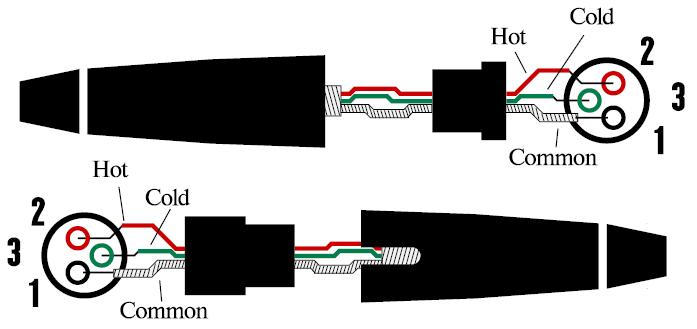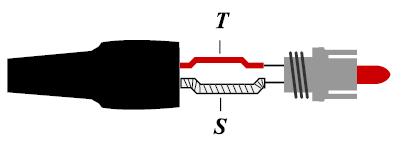Here are a few
basic connector hookups

IEC 268 Hum and
Noise Free Standard
* Never connect
shield to both ends - Connect to sending end only
* Separate
chassis ground and signal ground
* Use 2
conductor plus shield for unbalanced
Telescoping shields and
ground loops.
A ground loop is a voltage or current that can arise when multiple ground points
or devices are connected together via different lengths of cabling. Ground loops
can develop between both AC and audio signal paths. It may manifest itself as a
nagging hum, a high frequency buzz, or can even damage electronic components in
the interconnected devices. Telescoping a shield refers to the mechanical
connection of the shielded wire. To telescope a shield you would attach the
shield at one end of the cable and 'float' (leave it unattached) at the other
end.
Many power amp manufacturers such as Crown, Carver, Crest and QSC allow you the
luxury of floating the audio ground at the input of the power amp via a switch
or terminal strip. The PRIOR general rule of thumb had been to attach the shield
at sending device and float it at the receiving device. This applied everywhere
except at the mixing console inputs. Inputs to a console usually are floated at
the sending device and the receiving device - the console- remains grounded.
The Audio Engineering Society (AES) has developed a "Recommended
Grounding Practice". which differs from the method previously
stated above.
If you are using equipment manufactured before 1999, your sound system may
contain a mixture of both grounding conventions.
Due to legalities we cannot recommend either grounding procedure over the other.
The difference between
balanced and unbalanced signal lines
A balanced line uses a minimum of 2 wires to carry signals. One line is 180
degrees out of phase from the other. Neither of these two lines sits at ground
(0 volt). Any noise COMMON TO BOTH LINES is automatically cancelled by the
balanced device that accepts the signal. One advantage of using a balanced line
is the ability to run longer distances with less noise.

Balanced XLR

Standard XLR microphone connector
to be used with mic-level connections.

1/4" Mono

Standard mono/unbalanced phone
plug used for most mixer connections.

1/4" Stereo (TRS)

Standard stereo/balanced phone
plug used for balanced connections on most mixers.

RCA / Phono Plug

Standard phone plug used for
most Tape/CD deck connections.

Insert "Y" Cable

The "Y" Cable is used
for connecting serial effects devices, such as graphic equalizers or
compressors, to a mixer’s Channel or Bus insert jacks. On one end is a
standard Tip-Ring-Sleeve "stereo" plug. Its tip and ring are wired to
separate mono Tip-Sleeve plugs.
Note that the RING of the TRS plug
(A) is actually wired to the TIP of one of the mono plugs (B).

go
to top
